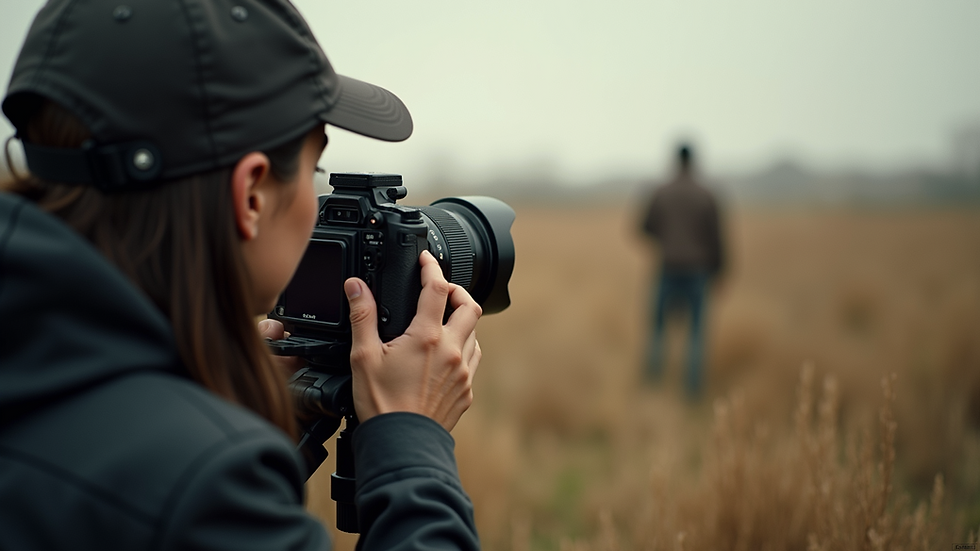Discover the Art of Filmmaking with Nasarc
- nitrosma9988
- Jul 7
- 4 min read
Filmmaking is a captivating blend of creativity, technology, and storytelling. It allows us to express ideas, evoke emotions, and share experiences. Whether you are a budding filmmaker or someone who simply loves movies, understanding the art of filmmaking can be incredibly rewarding. In this blog post, we will explore the essential elements of filmmaking, share practical tips, and highlight how Nasarc can help you on your journey.
Filmmaking is not just about pointing a camera and pressing record. It involves a series of steps that transform a simple idea into a visual masterpiece. From pre-production to post-production, each phase plays a crucial role in the final product.
The Pre-Production Phase
Pre-production is the planning stage of filmmaking. This is where you lay the groundwork for your project. Here are some key components of pre-production:
Scriptwriting
A strong script is the backbone of any film. It outlines the story, characters, and dialogue. When writing a script, consider the following:
Structure: Most scripts follow a three-act structure. This includes the setup, confrontation, and resolution.
Character Development: Create relatable characters with clear motivations. Audiences connect with characters who have depth.
Dialogue: Write natural-sounding dialogue that reflects each character's personality.
Storyboarding
Storyboarding is the process of creating a visual representation of your script. It helps you plan each shot and understand how the story will unfold visually.
Visualize Scenes: Sketch out key scenes to see how they will look on screen.
Shot Composition: Consider camera angles, framing, and movement.
Timing: Storyboards can help you determine the pacing of your film.
Casting
Choosing the right actors is vital. They bring your characters to life. Here are some tips for casting:
Auditions: Hold auditions to see how actors interpret your characters.
Chemistry: Look for actors who have good chemistry with each other.
Diversity: Consider diverse casting to reflect real-world experiences.
The Production Phase
Production is where the magic happens. This is when you shoot your film. Here are some important aspects to consider during production:
Equipment
Having the right equipment can make a significant difference in your film's quality. Here are some essentials:
Camera: Choose a camera that fits your budget and needs. DSLRs and mirrorless cameras are popular choices for indie filmmakers.
Lighting: Good lighting can enhance the mood of your film. Use natural light or invest in softbox lights for indoor shoots.
Sound: Clear audio is crucial. Use external microphones for better sound quality.
Directing
As a director, your vision guides the entire production. Here are some tips for effective directing:
Communication: Clearly communicate your vision to the cast and crew.
Flexibility: Be open to changes and improvisation during filming.
Focus on Performance: Work closely with actors to help them deliver their best performances.
Filming Techniques
Experimenting with different filming techniques can elevate your film. Here are a few to consider:
Camera Movement: Use techniques like pans, tilts, and tracking shots to add dynamism.
Framing: Pay attention to how you frame each shot. Use the rule of thirds for balanced compositions.
Depth of Field: Manipulate depth of field to draw attention to your subject.
The Post-Production Phase
Post-production is where you polish your film. This phase includes editing, sound design, and color correction.
Editing
Editing is crucial for shaping your film's narrative. Here are some tips for effective editing:
Software: Use editing software that suits your skill level. Options range from beginner-friendly programs to professional-grade software.
Pacing: Pay attention to the pacing of your film. Cut unnecessary scenes to keep the audience engaged.
Transitions: Use transitions wisely to maintain flow between scenes.
Sound Design
Sound design adds depth to your film. Here are some elements to consider:
Sound Effects: Use sound effects to enhance the realism of your film.
Music: Choose a soundtrack that complements the mood of your film.
Voiceovers: Consider adding voiceovers for narration or character thoughts.
Color Correction
Color correction can dramatically change the look of your film. Here are some tips:
Consistency: Ensure color consistency across all scenes.
Mood: Use color grading to evoke specific emotions.
Software: Use color correction software to achieve professional results.
The Role of Nasarc in Your Filmmaking Journey
Nasarc is a platform designed to support filmmakers at every stage of their journey. Here’s how Nasarc can help you:
Resources and Tutorials
Nasarc offers a wealth of resources, including tutorials on various aspects of filmmaking. Whether you need help with scriptwriting or editing, you can find valuable information to guide you.
Community Support
Joining a community of filmmakers can be incredibly beneficial. Nasarc provides a platform for filmmakers to connect, share experiences, and offer feedback. Engaging with others can inspire you and help you grow as a filmmaker.
Networking Opportunities
Networking is essential in the film industry. Nasarc hosts events and workshops where you can meet industry professionals, learn from their experiences, and potentially collaborate on future projects.
Final Thoughts
Filmmaking is an art that requires passion, dedication, and a willingness to learn. By understanding the different phases of filmmaking and utilizing resources like Nasarc, you can enhance your skills and bring your creative visions to life.
Remember, every great filmmaker started somewhere. Embrace the journey, keep experimenting, and most importantly, enjoy the process of storytelling through film.

As you embark on your filmmaking adventure, keep these tips in mind. The world of film is vast and full of possibilities. With each project, you will learn and grow, bringing you closer to mastering the art of filmmaking. Happy filming!



Comments